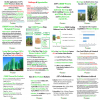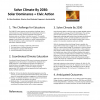Schools are pillars of communities. They provide children with inspiration, knowledge and tools to take into the world. Due to concerns about the climate crisis, biodiversity and plastic pollution facing our planet, students across the world are mobilizing and striking in protest of the lack of action, to raise awareness and to demand change to protect our futures.
Research Posters Being Presented as Lightning Talks
Curriculum Design for an Inclusive, Interdisciplinary Collegiate Wind Competition Course
The motivation of this research project was to design curriculum for an interdisciplinary and inclusive wind energy course, which would prepare students to attend the U.S. Department of Energy’s Collegiate Wind Competition (CWC). The CWC is attended by Penn State students every year and allows for many personal and professional development opportunities. A student wind energy club already exists at Penn State, but the gender diversity has historically trailed off throughout the year.
Drawdown Learn Conference: Empowering Schools & Communities to Address Climate Change
The Omega Center for Sustainable Living (OCSL) opened in 2009 with the construction of our EcoMachine, a natural wastewater reclamation facility designed in partnership with acclaimed biologist, John Todd. As the world’s first LEED Platinum and Living Building Challenge certified project, the center receives thousands of visitors and many school groups each year. In 2018 we worked with Project Drawdown to produce the first Drawdown Learn Conference.
Energy and Air Pollution Modeling for Cities: A Case Study on Cuba
Nowadays, energy consumption is dominated by fossil fuels. This situation leads to a large number of environmental problems intensifying climate change and human health risks. Scenario analysis through modeling can help design less-pollutant energy strategies.
Feeding Cities: Reconfiguring Urban Environments and Food Systems for Future Resilience
As we move towards a global population of 9 billion + with our urban areas hosting most of the planets people, the need to be creative in providing quality food in a responsible way is ever greater.
Flood and Soil Property Impacts on Crop Yields: Where Perennial Buffers May Make Sense Financially within Pennsylvania Watersheds
Flooding can lower annual cash crop yields and threaten the economic prosperity of farmers. As flooding events become more intense, frequent, and long-lasting due to the effects of climate change, more consideration is needed for which crops to place in high-risk areas. Previous studies have examined the broad impacts of weather events such as flooding or drought on crop yield and farmers’ revenue using long-term averages.
Localizing Drawdown: Collaboratively Building Regenerate Lancaster
Regenerate Lancaster is a collective of co-working individuals launching a Drawdown plan for Lancaster County, PA. Grounded in sustainability as a regenerative project for communities, economies, and ecologies (cf. Lovins, Wallis, Wijkman & Fullerton 2018; Raworth 2018; Rodale Institute; UN SDGs), we are identifying the twenty-five most relevant solutions for our place, connecting organizations to act on these solutions, and nurturing the initiatives we seed within our community.
Millersville University’s Net Zero Energy Building Creates Positive Energy Fund
Millersville University of Pennsylvania recently constructed a $7.5 million, 14,600 square-foot campus building that is currently undergoing review for Net-Zero Energy certification. The Lombardo Center houses the Admissions, Marketing, and Residence staff, and is also a Welcome Center with an educational focus.
Mirrors for Earth’s Energy Rebalancing (MEER:ReflEction): Resource-Driven Engineering Leveraging Earth’s Chemistries to Immediately Offer Remediation
Anthropogenic aerosols and greenhouse gases (GHG) enter the atmosphere as peoples exercise their unalienable rights in pursuit of well-being and prosperity. Once airborne, the aerosols cool the Earth almost as much as co-emitted GHG warm it. This balancing act has masked an additional 1C of warming, should the aerosols disappear when phasing out the fossil fuels without compensatory solar radiation management. In this scenario, existing knowledge about ecosystem responses project a probabl
More Cooling for Less Carbon – Why Designing With Moving Air Matters
Buildings account for 38% of greenhouse gas emissions from fossil fuel combustion, and heating, cooling, and ventilating buildings alone contributes 13% of national CO2 emissions. Globally, demand for cooling has doubled since 2000, and is projected to triple again by 2050 without ambitious changes in design and practice. One major strategy for reducing cooling energy use while maintaining comfort is using more air movement.
On-Site Application of ATP's CRBBP Process to Reduce the Adverse Environmental Impacts of Power Plants
I would like to inform you about the latest application of our recently-patented Combined Remediation Biomass and Bio-Product Production (CRBBP) Process, on-site, at coal-fired power plants, to cost-effectively reduce their adverse environmental impacts.
Quantifying and Reducing Halocarbon Emissions at Academic Institutions
Halocarbon gases are among the most powerful greenhouse gases ever emitted. Their global warming potentials are thousands of times greater than carbon dioxide, and their emissions account for 14% of current global warming. Halocarbons are also the fastest growing source of greenhouse gas emissions in developed countries. U.S. emission rates have increased nearly 250% since 1990, and unabated global emissions could induce an additional 0.5 ˚C of warming by 2100.
Realistic Ways to Drastically Reduce the CO2 Emission of Cement and Concrete
Portland cement concrete is the most widely used human-made material and makes up approximately 40% by mass of everything we produce. At the same time, it is responsible for 5 to 10% of the global anthropogenic CO2 emissions. Portland cement, the most critical ingredient of concrete, is made of the most available elements in Earth’s continental crust, as well as in other terrestrial planets.
Solve Climate By 2030: Solar Dominance + Citizen Action
This poster will discuss a climate education project sponsored by the Bard Center for Environmental Policy that, on April 8, 2020, will sponsor 52 simultaneous, university-hosted, state level webinars focused on the top 3 policy actions needed in each state to drive climate solutions.
Sustainable Development Goals: Curriculum Modules for Engineering
The Pennsylvania State University is updating engineering first-year seminars (FYS) to include ethics and humanities by incorporating more sustainability and human rights concepts. My research with Penn State’s Drawdown centered around creating new curriculum for Penn State FYS that incorporates the United Nation’s Sustainable Development Goals (SDGs).
The Future of Nuclear Energy: Small Modular Reactors and Generation IV, A New Hope
As climate change threatens to dramatically change the global landscape, the negative human impact on the environment must be reduced. Electricity production, through the burning of fossil fuels, is a major contributor to human-induced climate. This situation along with increasing energy demands motivates a massive shift to alternative carbon-free energy sources.
The Pathways Project: Local Planning and Federal Support for Low Carbon Infrastructure in the United States
2020 is shaping up to be a watershed moment for climate policy in the United States. The Green New Deal proposal has reopened the national conversation about infrastructure and climate change, and galvanized support in some important constituencies. It also raises a key dynamic for climate action, namely the interaction of local action and federal policy.
Trade-off Analysis on the Expansion of Frontier Agriculture in the Subarctic
By transforming the environmental conditions in the subarctic, climate change is creating an expansion opportunity for frontier agricultural production. In particular, interest is mounting in northern Ontario where there is a combination of warming temperatures that crops can thrive in, relatively inexpensive land prices, and government support for sector growth.

















